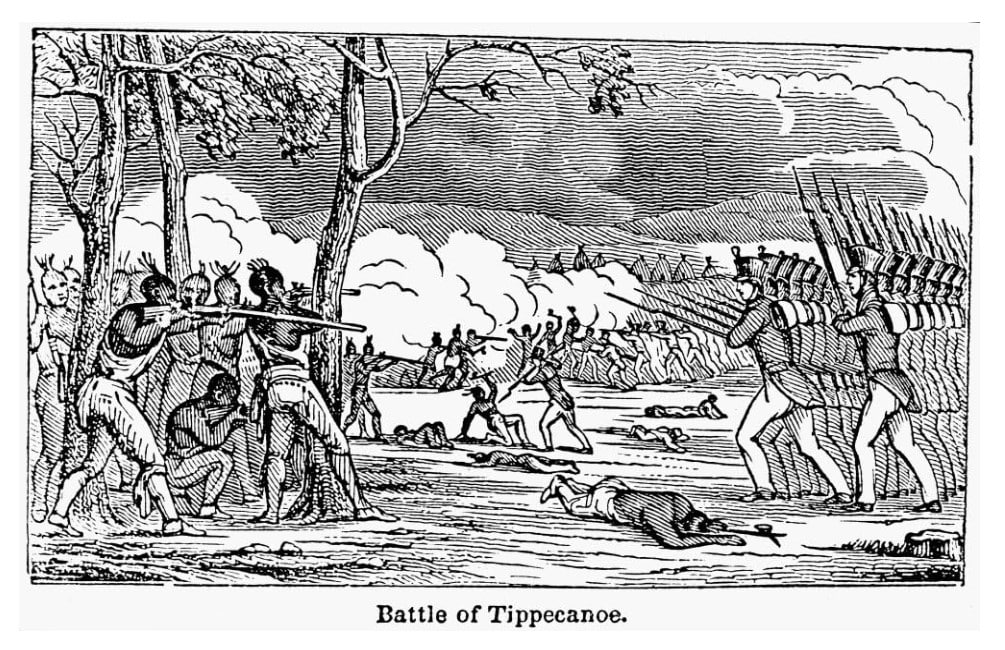By David Heighway, Hamilton County Historian
As we approach Veterans Day, it would be good to look at the service of a forgotten veteran whose grave is unmarked. Caleb Harrison (17??-1833) was an early settler of northern Hamilton County and a veteran of the Battle of Tippecanoe. Although the information is sparse, his experience is worth noting.
It’s difficult to find information about him because some of the records are unreliable, and there are people in the area at that time with the same name. There are also many strange claims of relationships. For example, there is a 1923 article which asked the somewhat outlandish question, “Was the Brother of Gen. Harrison Buried Near Clare?” Needless to say, this is not the case. Paula Dunn and others have done research and have found there were no known relatives of William Henry Harrison in Hamilton County. Another source claimed that he was related to Colonel Thomas Jefferson Harrison who commanded the 39th Indiana Infantry during the Civil War, but an actual connection hasn’t been found.
Then, there was Elmer Harrison (1866-1935), about whom a 1907 article said, “Mr. Harrison’s grandfather was one of first settlers of Hamilton County and is of the William Henry Harrison family.” Elmer’s grandfather was a different Caleb (1813-1851), and his great-grandfather Robert (1780-?) had no visible connection to the 9th president.
Available documents suggest that the veteran Caleb Harrison possibly first lived in Harrison County. This is where his military troop was formed and where he received an 1818 land patent. The 1820 census shows the head of a household by that name living in “Delaware County” near William Conner and the Finch family. (That area was the Delaware New Purchase, which was created by the Treaty of St. Mary’s in 1818 and later divided into the various counties of central Indiana.) His name is on a Marion County land patent in 1829 and as head of a household in the Marion County census listings in 1830. He was discussed by Augustus Finch Shirts in a 1901 history, who said that he died in Strawtown in 1833. This would mesh with the claim from the 1923 article which said that Harrison’s grave was somewhere on the farm of Arza Teter. There is a pioneer cemetery, mostly unmarked, on the site of Teter’s farm which is now the grounds of the Teter Family Retreat and Organic Farm near Strawtown.
Unusually, we have more information about his military service in Tecumseh’s uprising in 1811 than we do about the rest of his life. The official government muster roll says that he was a Private in the Indiana Militia in Lieutenant Thomas Berry’s detachment of mounted riflemen between September 29 and November 23, 1811. This group of soldiers had been assigned to Captain Spier Spencer’s company. Captain Spencer’s company was known as the “Yellow Jackets” because of their uniform and supposedly because of their fighting spirit. This unit took the brunt of the fighting during the Battle of Tippecanoe on November 7, 1811, and both Captain Spencer and Lieutenant Berry were killed. According to the Shirts history, Caleb Harrison “assisted in firing the first alarm guns on that occasion and had a bullet shot through the top of his hat.” Harrison’s service is confirmed by a news article from the Indianapolis Gazette of July 27, 1824, which reprinted a statement in which he said that he was at the battle and had seen John Conner participating enthusiastically. (Today, the story is problematic. Conner was running for the state legislature and had been accused of being sympathetic to Native Americans. This was regarded as a negative in 1824 politics.)
One of the curious aspects of Harrison’s story is that he may have connection to street names in early Noblesville. When William Conner and Josiah Polk platted the town of Noblesville, they made some odd and unexplained choices when naming the streets. For example, 9th Street was originally named “Catherine Street.” Since Conner’s wife was named Elizabeth and Polk was unmarried, no one knows who Catherine was. Another example is Cherry Street, which was originally named “Wiltshire Street,” presumably after the English county. Conner’s family was from Ireland, so there is no connection there.
On the 1823 plat of the city, the streets now called 5th and 6th were named “Brock” and “Harrison.” (The street known today as Harrison Street was “Voss Street.”) These names appeared on maps and in newspapers until 1893. One possible explanation for this choice is that there were two known veterans of the Battle of Tippecanoe who settled in Hamilton County – Caleb Harrison and Elijah Brock (1793-1868). As mentioned above, Harrison already knew the Conner family. Could this have been the inspiration for the names? If so, it would mean the military memorial at Riverside Cemetery is in an appropriate spot.



